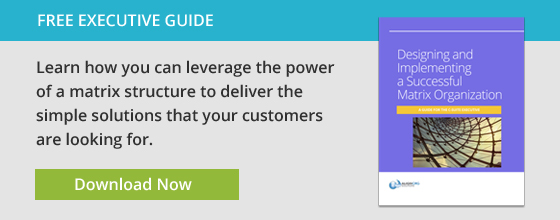Whether we like it or not, today’s marketplace is increasingly more complex. As a result, many organizations have turned to a matrix structure to help mitigate the complexities. However, most organizations fail to fully utilize a matrix and instead it becomes little more than a few dotted-line reporting relationships sprinkled throughout the organization chart. So, how do you fully utilize a matrix structure? How do you know if you need a matrix or if a matrix is right for your organization? And, what can you expect from a matrix?
When considering a matrix structure, organizations must first and foremost keep in mind how the new structure will impact their strategy and differentiation. Matrixes are designed to help organizations work across boundaries, maximize synergies/resources, and ultimately mitigate marketplace complexities. However, if a matrix doesn’t enhance your strategy and differentiation, adding a matrix structure to your organization can cause misalignment and subsequently decreased returns and productivity.
If organizations are unsure about their strategy, they need to address that issue prior to moving forward with a matrix structure. If an organization is unsure about how a matrix will affect their strategy, their go-to-market efforts, or feel that it will not help drive it, they should seriously reevaluate or reconsider adding a matrix (and all that comes with it) to their organization’s configuration.
If a matrix structure seems like a good fit with your organization and strategy, you must next determine if a matrix is the right linkage for your organization’s ultimate goals. There are many types of linkages – rules/policies, meetings, teams, liaison roles, shared goals, and matrix structure – to name a few. While most linkages are familiar to organization denizens, each linkage comes with a cost. The cost of a linkage is a combination of actual costs as well as embedded costs like the time and effort of organization members. In conjunction with the cost, executives should consider how effectively a linkage will help organization members coordinate across boundaries and mitigate risks—some linkages are quite powerful and others have limited reach.
As you may have guessed, the matrix structure is both the most expensive and the most powerful linkage. Before jumping headlong into a matrix structure, organizations should consider the cost of the linkage in relation to the extent to which they need to link across organizational boundaries and mitigate risks. It is, therefore, important to weigh these costs against the benefits before you introduce a matrix into your organization or continue with/give up on your current matrix structure. Adequately understanding the benefits and risks will help you:
- Determine if a matrix will drive your strategy and differentiation
- Mitigate risks prior to implementation
- Avoid diluted benefits
- Approximate the benefits you can expect in a matrix investment
The following explores the benefits of a matrix organization to better understand the potential benefits and risks of a matrix:
- Increased coordination. A matrix helps you increase the organization’s ability to coordinate across the organization.
- Synergies.When different groups work together within the business, organizations have the ability to benefit from synergies.
- Resource sharing. Similar to synergies, a matrix allows the organization to share costs.
- Increased productivity. As resources are shared across the organization, resources can potentially wear multiple hats so that savings can be reinvested, resources can be leveraged across different organizational dimensions, and coordination time can sometimes be eliminated because the same person or role is responsible for multiple outcomes.
- Better insight into profits/costs. When leaders can more easily see across multiple processes and/or phases of work, it facilitates greater insights into the costs of production of a product/service and their subsequent profits.
- Increased speed. The matrix can (if designed and optimized properly) accelerate decision making.
- Smarter product design. Like the creative synergies mentioned before, product design benefits from having multiple perspectives involved, bringing customer needs, technical capabilities, and regional nuances to the forefront.
While these benefits clearly help an organization bridge across boundaries and maximize efficiencies, they do come with a number of risks:
- More complicated performance management process. In a matrix organization, multiple individuals must provide feedback and input on performance management, and this often makes the process longer.
- Lack of clarity on decision rights. It is easy for organizations to get bogged down with questions of who has the authority or decision rights for different tasks.
- Increased politics. When people are unclear about who has decision rights, you see an increase in politics as individuals or groups vie for power, influence, or control over resources.
- Speed. One of the benefits of a matrix organization is speed in decision making. However, the inverse can also be the case if an organization fails to mitigate the potential communication “drags” such as added coordination meetings, communication requirements, and increase performance management requests.
- Matrix management skills. A matrix moves in multiple directions simultaneously, and if management cannot “go with the flow” of the organization and deal with dynamic nature of decision making, a matrix organization can prove to be a mystery for the most seasoned executive.
Many leaders give up on a structure—including a matrix structure—much too early because they were unwilling to figure out how to mitigate the risks. Doing so is a big mistake and only creates a cycle of regularly changing the structure of your organization at great market cost and wasted organization energy. On the flip side, many executives turn to a matrix structure thinking it will solve their organizational ills without fully appreciating the benefits and risks.
Is a matrix structure right for you? As is often the case, it depends. The questions you need to answer are: Does a matrix align with your strategy? Will the benefits of the matrix drive differentiation for your business? Can you live with and adequately mitigate the risks to achieve the full potential of the matrix structure? If you can confidently answer yes to these questions, a matrix is probably a good fit for your organization and has the potential to deliver the competitive advantage that you are looking for.
Editor’s note: This blog was originally published on Dec. 28, 2016. It has since been updated with new content.






